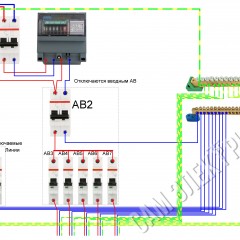What are the types of electrical work and when do you need a permit SRO
You probably saw ads like “A professional electrician will do all kinds of electrical work”, but you don’t have to list either the list of services he provides or what he can do at all. To clarify, we will tell you what types of electrical installation are in everyday life and in production.
Types of hidden and external works
To begin with, all electrical installation work in construction and repair in residential premises can be divided into two types - hidden and external.
The “hidden” work on the electrics in the apartment or in the cottage can be attributed to what is done before the walls are finished:
- Cable routing in the wall.
- Installation of wiring accessories.
- Wall chipping and embedment (although this looks more like a job for a plasterer or a bricklayer, in practice, electricians do this).
External concerns:
- Installation of open wiring on the surface of the walls.
- Installation of overhead wiring products.
- Installation of fixtures.
Such wiring is often used in a wooden house or in non-residential buildings.
But this is not all types of work performed indoors. There are a number of tasks in the electrical installation that are performed indoors during the construction and construction of a residential building:
- Laying overhead power lines.
- Electrical panel assembly and organization of electric power input.
- Installation of street lighting of an entrance or a personal plot.
- Commissioning of the backup power supply scheme.
- Installation and wiring grounding.
- Laying low-current and information networks.
When laying new lines, electricians use the following methods and types of marking during electrical work:
- Marking with a paint cord.
- By laser level (level).
- Pitch marking.
Both in everyday life and in production, the rules for the implementation and types of electrical work are spelled out in such regulatory documents as: codes of rules (JV) and building codes (SNiP), state standards (GOST) - for each industry, type of construction, they are different. Here are some commonly used documents in everyday life.
- SP 31.110-2003 or its updated version of SP 256.1325800.2016 “Electrical installations of residential and public buildings. Rules for design and installation "
- SP 23.05.95 or its updated version of SP 52.13330.2011 "Natural and artificial lighting."
- SP 31-105-2002 “Design and construction of energy-efficient single-family apartment buildings with a wooden frame” (the main document for frame construction).
It is worth noting that all decisions and actions of electricians must comply with such documents as PUE (Rules for the Installation of Electrical Installations), PTEEP (Rules for the Technical Operation of Electrical Installations of Consumers), ППЭЭП (Rules for Safe Operation ...) and others.
Features of work in production
In addition to standard operations similar to "household" wiring, such as installing fixtures, switches and sockets, electricians perform the following types of electrical work in production:
- Laying new lines of force (in trays, on partitions, by air and underground).
- Replacement of failed electrical equipment.
- Installation of new equipment, for example, conveyors, power panels, automation, crane equipment, etc.
- Commissioning at new production sites.
The main difference is that “private traders” are not allowed to conduct electrical installation and commissioning at the production site, and only trained personnel are allowed, with the appropriate access and qualification groups and who have been trained in safety and occupation. Persons who have been trained in TB and have an adequate level of physical fitness and an appropriate state of health are allowed to work at heights.
Contraindications to working at height are such problems as: abnormal pressure, poor eyesight (myopia), problems with the musculoskeletal system (joints, spine), cardiovascular diseases.
Before putting into operation, the installations are checked by an electric laboratory, and the location of equipment and cables, the length of the power lines are entered into statements, magazines and, if necessary, changes are made to the electrical design of the enterprise.
In what cases do you need SRO approval
There is such an organization as a self-regulatory organization (self-regulatory organization), by joining this organization you will receive an admission of self-regulatory organizations - this is an official permit to carry out all types of work.
In this regard, individual entrepreneurs and small construction companies have a question: do electricians need SRO approval and in what cases can they do without it? Let's try to answer it in simple words.
SRO approval is not needed if you are not involved in project activities, but are working at facilities already commissioned. Electrical work that does not require an SRO includes the installation of sockets, lamps, electrical panels and other tasks that arise when laying or replacing wiring, as well as in individual housing construction (IZHS).
If the object is only being built and electrical work is being carried out for the first time, then the employees must have an SRO permit.
So we examined the main types of electrical work in everyday life and in production. If you have any questions or additions to the material, write in the comments, we will discuss everything!
Related materials:











